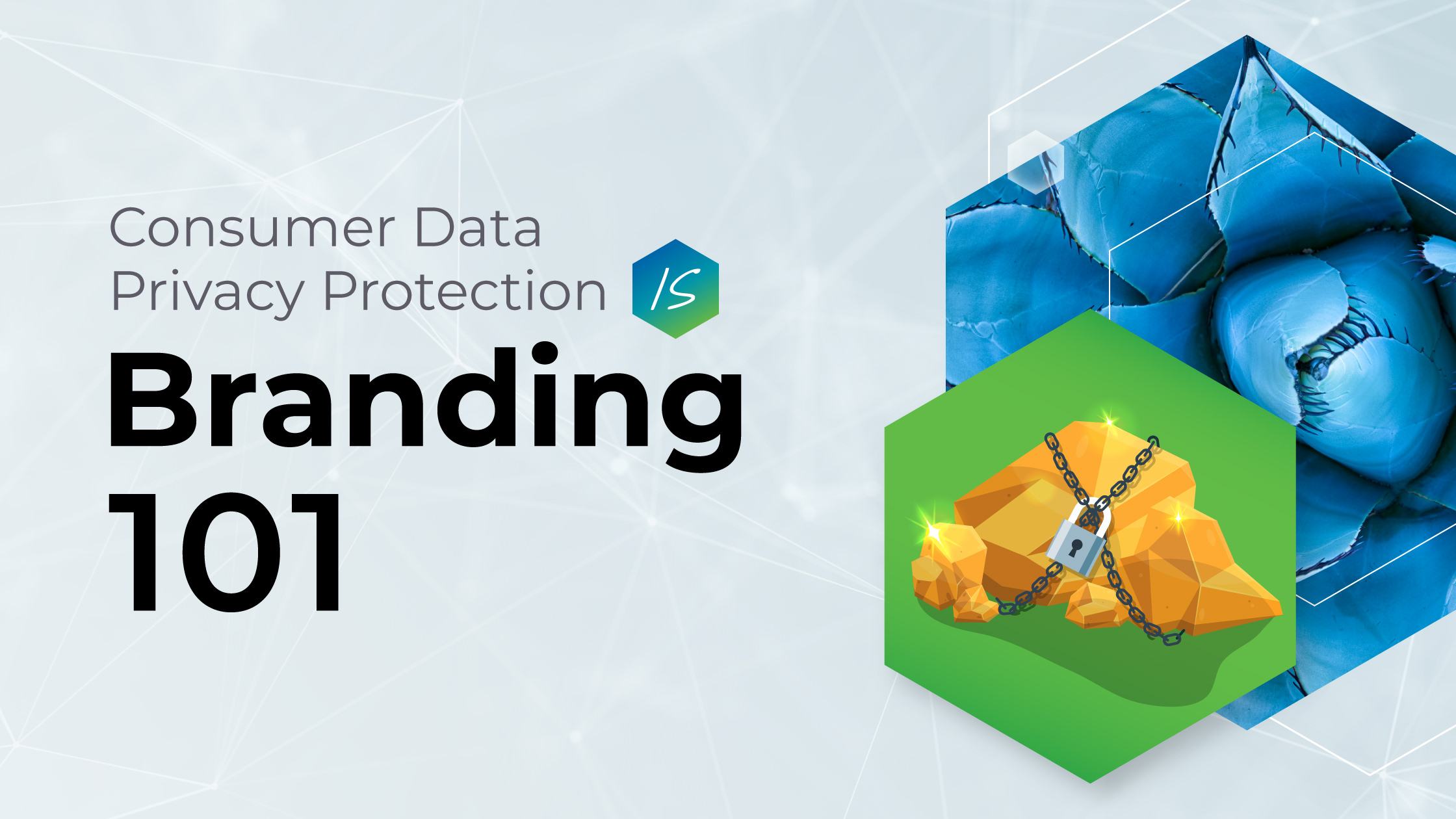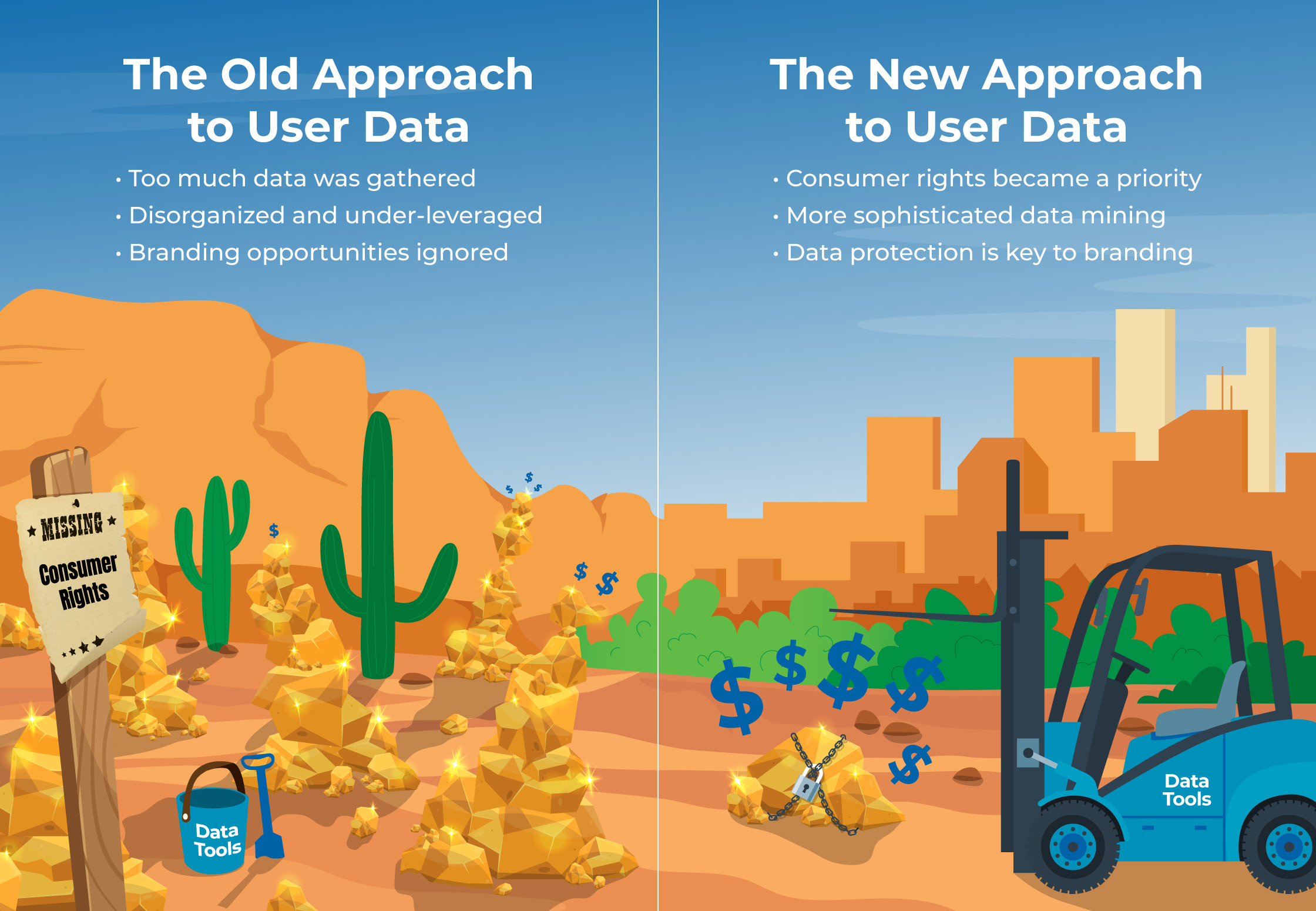
Thanks to the abundance of digital footprints, things like usage analytics and targeted advertising have become commonplace in digital marketing.
But this “information revolution” has come with a pressing concern – what’s the best way to keep all this data protected?
Today’s brands find themselves at a pivotal juncture where ensuring data privacy isn’t only about legal compliance — it’s about securing consumer trust, fostering brand loyalty, and cementing their position as ethical leaders in the digital landscape.
To help you do just that, we’re covering:
- Historical context of data privacy practices
- What is privacy-first marketing?
- Why data management is a BIG branding opportunity
- 12 components of a brand-centric privacy-first marketing strategy
The Old World of Consumer Data Privacy
The digital landscape used to be the Wild West.
User data was the new gold, and businesses could mine it without restrictions. Companies all over the world collected, stored, and shared data with little oversight, solely focused on optimizing business growth.
Many of these companies also grabbed the opportunity to generate an additional revenue stream by selling aggregated data to interested parties.
Sounds like a nonstop party, right? Except, there were three enormous cracks in the foundation of this house:
- Far too much data was being collected.
- The resulting mass was particularly unstructured.
- As a result, very few brands ever leveraged their user data in ways that were globally helpful to the business.
And then the tides turned…
As stories of data breaches and improper handling started to hit headlines, the collective consciousness around data protection surged to new heights.
Aware of how much personally-identifying data gets stored by any given company, consumers nowadays are demanding, at the very least, transparency. They want to know precisely how their private data is being used, shared, and protected.

The New World of Consumer Data Privacy
Heightened concerns about data privacy protections weren’t just driven by consumer fear of the misuse of their data, but also by brands who are increasingly recognizing the immense value of customer data in strategic decision-making and business operations.
It’s true that global regulations like GDPR and CCPA have evolved the landscape in recent years. But where non-compliance used to be just a risk of penalties, it’s now become a reputational hazard.
Brands seen as negligent or careless with data can face backlash, not just from clients and customers, but also from other stakeholders throughout the supply chain.
Common mishandlings of New World Data Privacy
Tripping over their ankles to avoid brand-debilitating data breaches and pricey penalty fees (not to mention the lawsuits), many brands have taken an aggressive ‘Kitchen Sink’ approach to data privacy.
The result?
These brands bombard website visitors with GDPR consent forms or recurring tracking alerts that add friction to the user experience and send potential clients bouncing off the page.
Clearly, this hurts conversion in the short term. But it’s also important to consider the long-term negative impact to search rankings, which are calculated in consideration of metrics like:
- Time on site
- Page views per session
- Bounce rate, and more.
Other businesses provide little to no transparency around what data they’re storing, using, or sharing, forcing would-be customers to look elsewhere when making a purchasing decision.
Transparent and ethical data practices aren’t just about compliance. A privacy-first marketing narrative helps persuade prospects and retain satisfied customers.
Granted, doing so is a delicate dance between leveraging insights and maintaining client trust — personalization vs privacy — and it’s in getting this mixture right that can make or break a successful privacy-first approach.
AI meets data privacy
The fast pace of technological innovation has only accelerated data protection concerns.
With the rise of AI, machine learning, and more sophisticated forms of marketing analytics, the amount of valuable information that can be gathered from user data is oftentimes staggering.
Even the most minute digital interactions can reveal patterns and insights about individual behaviors, preferences, and potential future actions a user might take. Adapting to this, there’s a growing interest in innovative techniques to protect user data.
For example, some companies are experimenting with blockchains, most commonly associated with cryptocurrency, to provide decentralized and anonymous data storage. Data is first encrypted and then spread across a decentralized blockchain network, providing a far more secure system than if that data were kept on a centralized server.
Data privacy strategies MUST align with UX best practices
MISTAKE: Thinking data privacy is solely the domain of lawyers and your IT team.
User experience (UX) intersects significantly with data privacy practices, which is why your marketing partners experts should be involved in every discussion about data privacy, with their dedicated subject matter experts in key areas like:
- Engagement design
- User journey continuity
- Data capture ease
- Marketing analytics
- UX QA
Category leaders are investing heavily in creating intuitive privacy experiences, ensuring that the user’s journey remains uninterrupted while their data remains secure.
The smart move is to recognize that this New World of Data Privacy represents a potent business opportunity to create a “privacy by design” strategy, strengthening trust and loyalty with both potential and current clients.
The brands that will ultimately thrive in this environment will be those that don’t simply adapt to the changing landscape but also preemptively innovate to stay ahead of potential challenges.
What is privacy-first marketing?
Brands that display their proactive approach to consumer data privacy in their marketing initiatives are said to be engaging in “privacy-first marketing”. Here, user privacy is not only not an afterthought, it’s a forethought.
But beyond the suggestions of building privacy into a brand narrative, companies need to make sure the overall user journey is as seamless as possible with regards to privacy marketing. Just slapping a cookie consent form onto your website might actually be hurting the overall user experience of the website.
In general, brands that view data compliance as an obstruction unsurprisingly end up creating unnecessary obstacles for their users — leading to things like bad website UX, which ultimately leads to poor organic rankings and lower conversion rates.
Being conscious about weaving privacy into your brand identity helps you think in a holistic way, allowing you to answer questions like:
- What do our users want in terms of privacy and how are we giving that to them?
- Is our privacy and cookie policy clear and understandable?
- How navigable is our website UX with respect to opt-in forms?
- Does our brand narrative promote a culture of data security or is user privacy just a compliance checkmark?
- Do we provide the right balance between analytics and anonymity?
- Are we adapting our marketing strategy to meet the growing demand for digital data ethics?
- Why are we sharing user data with outside entities, and how do we ensure that that shared data stays secure?
- How are we receiving and implementing feedback about our data practices?
- In the event of a breach, how well-prepared are we to communicate with our affected users?

Having these privacy-first questions in mind will inevitably lead to a branding strategy that makes sure users can:
- seamlessly interact with your brand
- confidently trust you with their personal data
- become enthusiastic brand advocates because of their regard for your regard for their data and overall user experience
The Big Perspective Shift: Data privacy is an essential part of your branding strategy
Now that we’re firmly planted in this new age of online privacy, what exactly can you do to create a consumer marketing privacy strategy that has a positive effect on your brand’s bottom line?
We can boil it down to these 3 steps:
Step 1: Meet the baseline requirements.
For starters, you should ensure that your data collection practices are compliant with relevant regulations and data protection laws.
If that foundation isn’t there, it’s impossible to promote your commitment to consumer protection in your marketing.
Step 2: Humanize your data privacy policy.
Next, create a data privacy policy that’s clear, concise, and easy to understand. Dense legalese is great for lawyers, but it’s terrible for everyone else.
Add short summaries within the privacy policy that explain, in simple language, what the dense legalese is saying.
Step 3: Add data conscientiousness as a pillar of your marketing messaging.
Now you’re ready to let your customers know about your data privacy practices. But this is not a tiny paragraph buried at the bottom of your next email newsletter.
Develop a plan for highlighting your commitment to user privacy as a point of innovation — one that’s articulated in varying ways to match the user’s progression throughout the funnel.
The increasing need for data protection is a golden branding opportunity. Use it.
Now, let’s go a layer deeper…
12 ways to make sure you’re enacting a marketing strategy built on privacy
- Let’s start with the most obvious: Familiarize yourself with relevant data privacy regulations in the regions where you operate (e.g., GDPR, CCPA) and confirm whether you need to appoint a Data Protection Officer (DPO)
- Conduct a Data Minimization Audit to determine whether you’re collecting only the data that’s necessary for your marketing efforts. Avoid collecting excessive or irrelevant information.
- Align on where and how often (on your site and in marketing content) you’ll communicate how you collect, use, and store data in easy-to-understand language.
- Ask your content marketing strategists to develop a collection of assets for articulating data privacy as a brand pillar, including case studies showing how privacy enhances user experience.
- Implement consent mechanisms that allow users to easily opt-in or out of data collection and processing, access, correct, delete, or transfer their data.
- Establish inclusive marketing guidelines for data usage within your organization.
- Implement robust data security measures to protect user data from breaches and unauthorized access.
- Ensure that privacy practices are consistent across all marketing channels, including email, social media, websites, and mobile apps.
- If you work with third-party vendors, evaluate their data privacy practices and ensure they align with your privacy-first strategy.
- Conduct PIAs to evaluate the potential privacy risks associated with new marketing initiatives, products, or services.
- Conduct regular audits of your data handling practices and assess their alignment with privacy principles. Make necessary adjustments as needed.
- Develop a robust data breach response plan to minimize the impact of any potential data breaches and to comply with notification requirements.
TL;DR on Data Privacy as Branding 101
- Data privacy management requires a holistic, privacy-first marketing approach that integrates Legal, IT, Marketing Strategy and UX.
- With user privacy as a brand pillar, brands have the opportunity to increase user engagement, which can drive performance by providing more insight into their user personas, buying journeys, and overall satisfaction levels.
- Marketing and promotional materials should weave data privacy compliance into the brand’s core identity — this “edge” will often push a prospect into a client.
- Instead of trying to obfuscate around data protection, companies need to be as forthcoming as possible about their data privacy policies. Showing clients what’s going on behind the scenes builds long-term trust.




